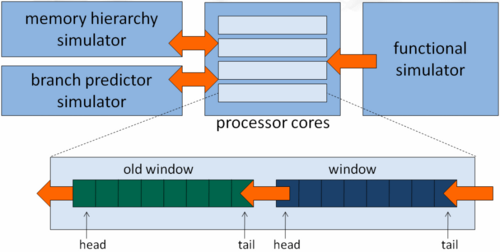Difference between revisions of "Interval Simulation"
| (One intermediate revision by the same user not shown) | |||
| Line 1: | Line 1: | ||
[[File:Interval.png|right|500px]] | [[File:Interval.png|right|500px]] | ||
| − | Interval simulation is a recently proposed simulation approach for simulating multi-core and multiprocessor systems at a higher level of abstraction compared to current practice of detailed cycle-accurate simulation. This technique leverages a mechanistic analytical model to abstract core performance by driving the timing simulation of an individual core without the detailed tracking of individual instructions through the core's pipeline stages. The foundation of the model is that miss events (like branch mispredictions, cache and TLB misses, serialization instructions, etc) divide the smooth streaming of instructions through the pipeline into | + | Interval simulation is a recently proposed simulation approach for simulating multi-core and multiprocessor systems at a higher level of abstraction compared to current practice of detailed cycle-accurate simulation. This technique leverages a mechanistic analytical model to abstract core performance by driving the timing simulation of an individual core without the detailed tracking of individual instructions through the core's pipeline stages. The foundation of the model is that miss events (like branch mispredictions, cache and TLB misses, serialization instructions, etc.) divide the smooth streaming of instructions through the pipeline into intervals. Branch predictor, memory hierarchy, cache coherence and interconnection network simulators determine |
the miss events; the analytical model derives the timing for each interval. The cooperation between the mechanistic analytical model and the miss event simulators enables the modeling of the tight performance entanglement between co-executing threads on multi-core processors. | the miss events; the analytical model derives the timing for each interval. The cooperation between the mechanistic analytical model and the miss event simulators enables the modeling of the tight performance entanglement between co-executing threads on multi-core processors. | ||
Latest revision as of 06:47, 29 May 2012
Interval simulation is a recently proposed simulation approach for simulating multi-core and multiprocessor systems at a higher level of abstraction compared to current practice of detailed cycle-accurate simulation. This technique leverages a mechanistic analytical model to abstract core performance by driving the timing simulation of an individual core without the detailed tracking of individual instructions through the core's pipeline stages. The foundation of the model is that miss events (like branch mispredictions, cache and TLB misses, serialization instructions, etc.) divide the smooth streaming of instructions through the pipeline into intervals. Branch predictor, memory hierarchy, cache coherence and interconnection network simulators determine the miss events; the analytical model derives the timing for each interval. The cooperation between the mechanistic analytical model and the miss event simulators enables the modeling of the tight performance entanglement between co-executing threads on multi-core processors.
The multi-core interval simulator models the timing for the individual cores. The simulator maintains a window of instructions for each simulated core. This window of instructions corresponds to the reorder buffer of a superscalar out-of-order processor, and is used to determine miss events that are overlapped by long-latency load misses. The functional simulator feeds instructions into this window at the window tail. Core-level progress (i.e., timing simulation) is derived by considering the instruction at the window head. In case of an I-cache miss, the core simulated time is increased by the miss latency. In case of a branch misprediction, the branch resolution time plus the front-end pipeline depth is added to the core simulated time, i.e., this is to model the penalty for executing the chain of dependent instructions leading to the mispredicted branch plus the number of cycles needed to refill the front-end pipeline. In case of a long-latency load (i.e., a last-level cache miss or cache coherence miss), we add the miss latency to the core sim-ulated time, and we scan the window for independent miss events (cache misses and branch mispredictions) that are overlapped by the long-latency load - second-order effects. For a serializing instruction, we add the window drain time to the simulated core time. If none of the above cases applies, we dispatch instructions at the effective dispatch rate, which takes into account inter-instruction dependencies as well as their execution latencies.
Davy Genbrugge, Stijn Eyerman and Lieven Eeckhout. Interval Simulation: Raising the Level of Abstraction in Architectural Simulation. Proceedings of HPCA, pp. 307-318, Feb 2010

